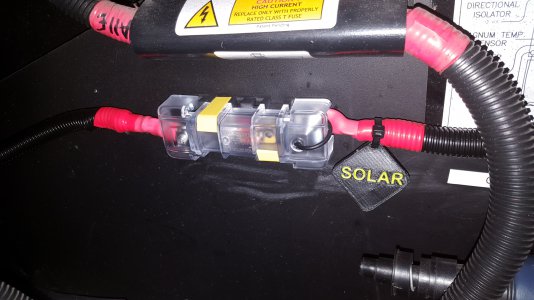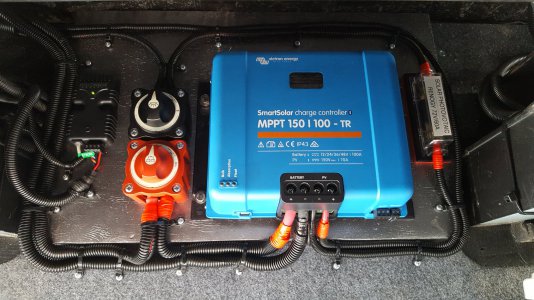Chuggs
RVF Supporter
- Joined
- Nov 3, 2019
- Messages
- 620
- RV Year
- 2016
- RV Make
- Newmar
- RV Model
- Ventana 4037
- RV Length
- 40’
- TOW/TOAD
- Jeep JKU
Ahhh....Interesting, disconnect the converter to avoid a LOOP. That has told us a lot...
It appears they have installed your Solar/Inverter system...not as a Solar System, per se...but as a Solar Generator. I'm guessing here...but I have seen this used, generally as a short cut when adding an Inverter.
The batteries power the inverter, and the coaches existing shore cord is plugged into a receptacle on the output of the inverter. You are told to disconnect the converter because the inverter is taking 12vdc from the battery, then changing it to 120vac...your power cord takes this...thinking it is shore power...and converts it back to 12vdc to charge your batteries. The converter and inverter are shy of having 100% efficiency...so all you do is loose power by looping the energy thru two devices that have limited efficiency. It is a way to avoid using an automatic transfer switch, and you have probably avoided a dedicated inverter sub panel, your inverter doesn't have an AC input for shore power pass thru... These additional features all make the system behave without a lot of operator input.
I think @Neal has the right idea. Your solar should be wired to the batteries. It is code to have current protection on the wiring...and for maintenance switches to isolate the system. Look for fuses, switches, or Marine DC breaker switches. If one of these tripped...or was turned off...your solar system is inert. When turning the system ON...it is best practice to begin with both the Photovoltaic side, and battery side turned OFF. You then connect the battery side. This gives your solar controller power to turn it's brains on...so to speak. After that...turn on the Photovoltaic side...and it will condition that power accordingly to charge the batteries. If you are disconnecting the system...do the reverse. Turn off PV first...then battery.
You are working with a system that uses a work around. It is basically allowing you to use the Inverter...on all of your houses AC wiring...by pluging in the original wiring into the inverter vs a shore receptacle. If you unplug from the inverter..turn your converter back on...and fire up the generator or plug back j to a shore power receptacle... you should be able to recharge the batteries.
So, there is going to be a lot of manipulation involved each time you want to use the shore power or generator power vs off grid using solar&battery to power thru the inverter with the converter disabled.
It now makes more sense...the only way you can charge your battery is thru the alternator with the engine running...and solar either has not been sufficient or has tripped and is not charging at all.
It appears they have installed your Solar/Inverter system...not as a Solar System, per se...but as a Solar Generator. I'm guessing here...but I have seen this used, generally as a short cut when adding an Inverter.
The batteries power the inverter, and the coaches existing shore cord is plugged into a receptacle on the output of the inverter. You are told to disconnect the converter because the inverter is taking 12vdc from the battery, then changing it to 120vac...your power cord takes this...thinking it is shore power...and converts it back to 12vdc to charge your batteries. The converter and inverter are shy of having 100% efficiency...so all you do is loose power by looping the energy thru two devices that have limited efficiency. It is a way to avoid using an automatic transfer switch, and you have probably avoided a dedicated inverter sub panel, your inverter doesn't have an AC input for shore power pass thru... These additional features all make the system behave without a lot of operator input.
I think @Neal has the right idea. Your solar should be wired to the batteries. It is code to have current protection on the wiring...and for maintenance switches to isolate the system. Look for fuses, switches, or Marine DC breaker switches. If one of these tripped...or was turned off...your solar system is inert. When turning the system ON...it is best practice to begin with both the Photovoltaic side, and battery side turned OFF. You then connect the battery side. This gives your solar controller power to turn it's brains on...so to speak. After that...turn on the Photovoltaic side...and it will condition that power accordingly to charge the batteries. If you are disconnecting the system...do the reverse. Turn off PV first...then battery.
You are working with a system that uses a work around. It is basically allowing you to use the Inverter...on all of your houses AC wiring...by pluging in the original wiring into the inverter vs a shore receptacle. If you unplug from the inverter..turn your converter back on...and fire up the generator or plug back j to a shore power receptacle... you should be able to recharge the batteries.
So, there is going to be a lot of manipulation involved each time you want to use the shore power or generator power vs off grid using solar&battery to power thru the inverter with the converter disabled.
It now makes more sense...the only way you can charge your battery is thru the alternator with the engine running...and solar either has not been sufficient or has tripped and is not charging at all.
Last edited:













